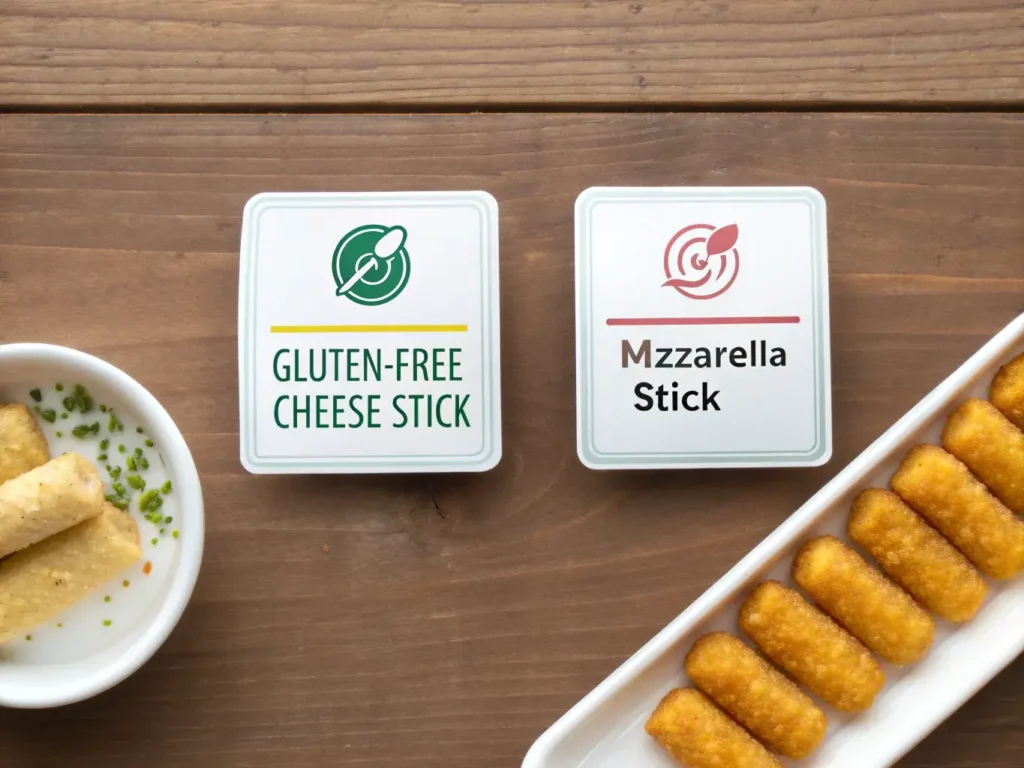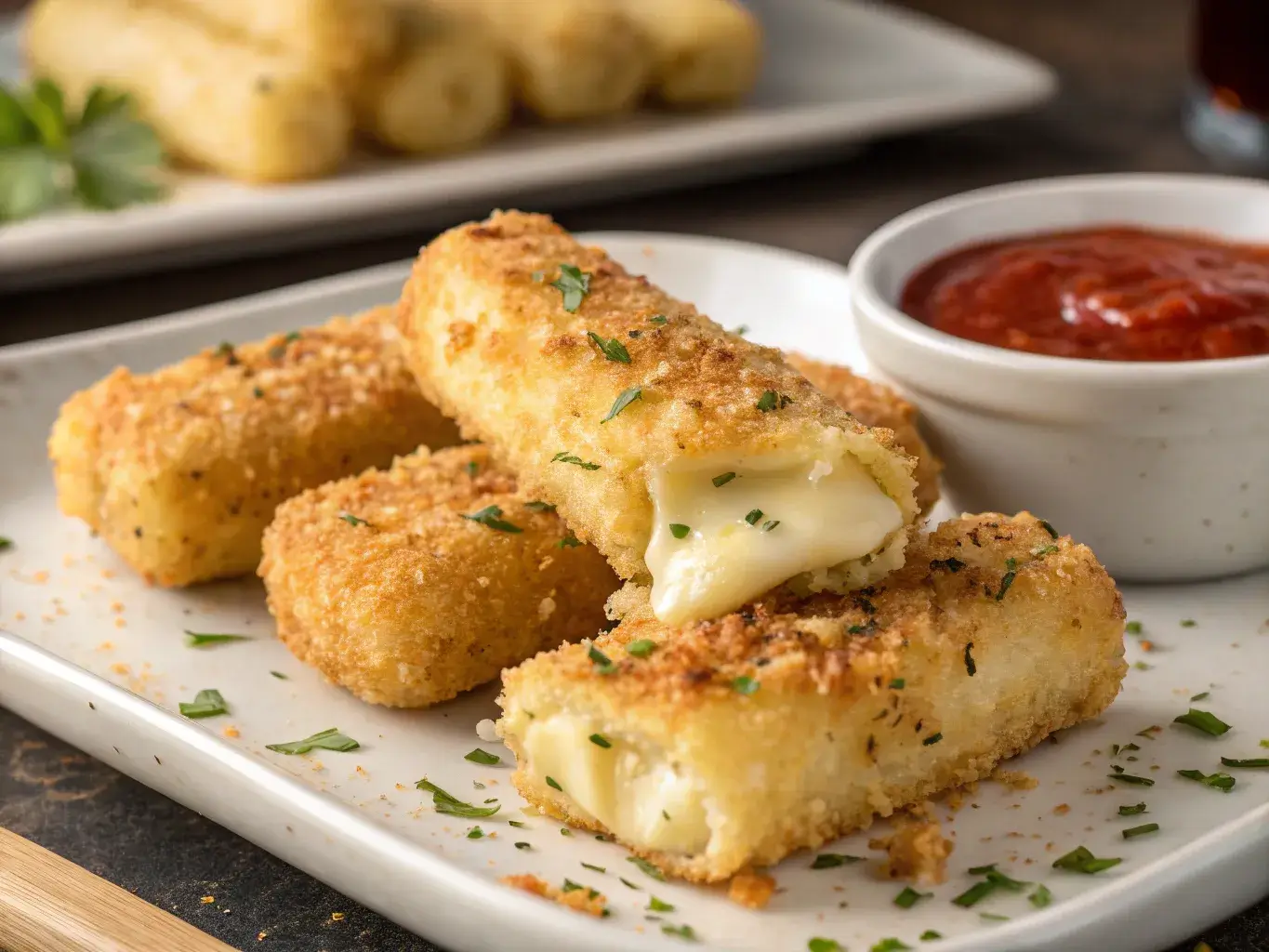If you’re living a gluten-free lifestyle due to celiac disease, gluten sensitivity, or simply personal health preferences, finding satisfying snacks can feel limiting. Thankfully, gluten free cheese sticks are not only a delicious option but also versatile and easy to enjoy whether homemade or store-bought. In this comprehensive guide, you’ll learn everything from what makes a cheese stick gluten-free to the best brands on the market, how to make your own at home, and what to look out for in labels. You’ll also discover frying and baking methods, nutritional tips, and shopping hacks that make enjoying these gooey snacks safe and fun.
Don’t miss our Gluten-Free Quiche Recipe for another delicious, celiac-friendly bite.
Understanding Gluten Free Cheese Stick
What is Gluten? How It Affects Celiac and Gluten-Sensitive Individuals
Gluten is a protein naturally found in wheat, rye, barley, and triticale. While it’s harmless for most people, individuals with celiac disease or gluten intolerance experience a range of symptoms—from digestive upset to long-term autoimmune complications—when consuming gluten. For them, even trace amounts can cause damage.
Gluten can sneak into surprising foods—especially processed items like cheese snacks—through additives, thickeners, or cross-contamination during manufacturing. That’s why checking labels and certifications is essential when buying pre-packaged cheese sticks.
Print
Gluten Free Cheese Stick: The Best Homemade & Store-Bought Options
- Total Time: 55 min
- Yield: 16 cheese sticks 1x
Description
Crispy, gooey gluten free cheese sticks made with mozzarella and coated in seasoned gluten-free breadcrumbs—perfect as a snack or party appetizer.
Ingredients
8 mozzarella string cheese sticks
1/2 cup gluten-free breadcrumbs
1/4 cup grated Parmesan cheese
1 tsp Italian seasoning
1/2 tsp garlic powder
1/4 tsp salt
2 large eggs, beaten
1/4 cup gluten-free flour
Oil for frying (vegetable or canola)
Optional: marinara sauce for dipping
Instructions
1. Cut cheese sticks in half to make 16 pieces. Place on a tray and freeze for 30 minutes.
2. Prepare three bowls: one with gluten-free flour, one with beaten eggs, and one with a mix of gluten-free breadcrumbs, Parmesan, Italian seasoning, garlic powder, and salt.
3. Dip each frozen cheese stick in flour, then egg, then breadcrumb mixture. Repeat egg and breadcrumb steps for extra coating if desired.
4. Place coated sticks on a tray and freeze again for at least 15 minutes to prevent melting during frying.
5. Heat oil in a deep skillet to 350°F (175°C).
6. Fry cheese sticks in batches for 1–2 minutes until golden brown. Do not overcrowd the pan.
7. Drain on paper towels and serve hot with marinara sauce if desired.
Notes
Double-coating ensures crispiness and prevents cheese leaks.
For a baked version, spray with oil and bake at 400°F for 10–12 minutes.
Can be frozen after breading for up to 1 month and fried straight from frozen.
- Prep Time: 45 min
- Cook Time: 10 min
- Category: Appetizer
- Method: Frying
- Cuisine: American
Nutrition
- Serving Size: 2 sticks
- Calories: 180
- Sugar: 1g
- Sodium: 320mg
- Fat: 12g
- Saturated Fat: 6g
- Unsaturated Fat: 5g
- Trans Fat: 0g
- Carbohydrates: 7g
- Fiber: 0g
- Protein: 10g
- Cholesterol: 45mg
Keywords: gluten free cheese sticks, mozzarella sticks, gluten free appetizer, homemade cheese snacks
What Are Cheese Sticks Made Of? Basic Ingredients and Gluten Risks
At their core, cheese sticks are simply sticks or logs of cheese, typically mozzarella or a blend of cheeses. On their own, natural cheese sticks are typically gluten free. However, trouble arises when cheese sticks are:
- Breaded (like mozzarella sticks)
- Flavored with spice blends or coatings
- Processed in facilities that handle gluten
Ingredients to watch out for include wheat starch, modified food starch (unless specified gluten-free), maltodextrin (unless derived from corn), and artificial flavorings or preservatives.
To stay safe, always opt for:
- Brands labeled Certified Gluten-Free
- Cheese sticks from companies with strict allergen control
Looking for inspiration? Try our Carrot Cake Cookies Recipe for a sweet gluten-free treat.
Are Gluten Free Cheese Stick?
Common Ingredients in Cheese Sticks That May Contain Gluten
While plain cheese is naturally gluten free, not all cheese sticks are created equal. Many store-bought cheese sticks or mozzarella sticks (especially the frozen, breaded kind) may include hidden gluten sources. Let’s break down what to look for.
Ingredients that can contain gluten:
| Ingredient | Why It’s Risky |
|---|---|
| Modified food starch | Can be derived from wheat unless labeled gluten free |
| Maltodextrin | May come from wheat in non-USA products |
| Wheat flour | Used in breaded cheese sticks |
| Natural flavors | Sometimes include gluten-based carriers |
| Seasoning blends | Can contain wheat or barley-derived ingredients |
🔥 Tip: Always read the ingredient list carefully and look for certifications like “Certified Gluten-Free” or “Tested to under 20 ppm of gluten.”
Don’t miss our Moist Strawberry Banana Cake if you’re craving a soft, gluten-free dessert after your snack.
Which Brands Make Gluten-Free Cheese Sticks?
Good news—there are several cheese stick brands that clearly label their products as gluten free cheese stick, making them safe for people with celiac or gluten sensitivity. Let’s take a look:
| Brand | Gluten-Free Status | Notes |
|---|---|---|
| Frigo Cheese Heads | Yes | Plain varieties are gluten free |
| Sargento String Cheese | Yes | All-natural, no gluten ingredients |
| Horizon Organic | Yes | Certified organic, gluten-free options available |
| Organic Valley | Yes | Certified gluten free and pasture-raised milk |
| Trader Joe’s | Most are | Always double-check labels for flavored versions |
Some flavored versions like “jalapeño,” “smoked,” or “herbed” may contain additives that aren’t gluten free—so stick with the original cheese versions if you’re unsure.
🧀 Pro Tip: Keep a go-to list of certified brands for safe snacking or kid-friendly lunches.
Discover great ideas like our Carrot Protein Cake to round out your gluten-free menu with a healthy dessert.
Store-Bought Gluten Free Cheese Stick Brands
Are Frigo Gluten Free Cheese Stick? Brand Overview and Certification
Frigo Cheese Heads are one of the most popular string cheese brands in the U.S.—and they’re a great option for gluten-free snackers. According to their manufacturer, the classic mozzarella Frigo Cheese Heads are gluten free, containing no wheat, rye, or barley ingredients. These cheese sticks are also made in a facility that follows allergen control practices, making them a reliable option for people with gluten sensitivities.
Frigo Gluten-Free Highlights:
- Classic string cheese (mozzarella) is safe
- Low moisture, part-skim mozzarella
- No gluten ingredients or cross-contaminants
- Not all flavored versions (like smoked or spicy) are guaranteed gluten free—check each product individually
Frigo doesn’t carry the “Certified Gluten-Free” seal but meets FDA standards of less than 20 parts per million of gluten in their plain varieties.
Are Sargento Gluten Free Cheese Stick? Label Analysis and Safety
Sargento String Cheese is another trusted name in natural cheese snacks. According to Sargento’s official allergen info, all their natural cheese products, including their mozzarella sticks, are gluten free.
Sargento Gluten-Free Advantages:
- Uses 100% real cheese with no fillers
- No added starches, coatings, or breading
- Produced in facilities that test for gluten presence
- Clear labeling practices and allergen transparency
Sargento cheese sticks come in a wide range of flavors and cheese types—cheddar, pepper jack, Colby Jack—but you should always check the packaging of flavored items for updated allergen info.
Looking for more gluten-free snack ideas? Don’t miss our in-depth guide on Are Kix Cereal Gluten Free? to round out your pantry.
How to Make Gluten Free Cheese Sticks at Home
Homemade gluten free cheese sticks are a game changer—not only can you control every ingredient, but they’re also cheaper, fresher, and free from hidden gluten risks. Whether you’re craving a crispy snack or prepping school lunches, this recipe gives you full flavor with zero compromise.

Ingredients You Need for Gluten-Free Cheese Sticks
Here’s a basic ingredient list to make about 12 cheese sticks:
| Ingredient | Quantity | Notes |
|---|---|---|
| Mozzarella cheese sticks | 12 sticks | Use whole milk for creaminess |
| Gluten-free breadcrumbs | 1 cup | Use almond flour, crushed rice crackers, or GF panko |
| Eggs | 2 | Lightly beaten for dredging |
| Gluten-free flour | ½ cup | Rice flour or a certified GF all-purpose blend |
| Garlic powder | 1 tsp | Optional for flavor |
| Italian seasoning | 1 tsp | Make sure it’s gluten free |
| Salt & black pepper | To taste | Adjust as needed |
| Cooking oil | For frying | Choose high-heat oils like avocado or vegetable oil |
📝 Tip: Place cheese sticks in the freezer for 30 minutes before breading to prevent melting during frying.
Looking for something sweet after your savory snack? Check out our Moist Strawberry Banana Cake—it’s gluten free and super easy to make.
Step-by-Step Recipe for Homemade Gluten-Free Cheese Sticks
Here’s how to make crispy, golden, gluten-free cheese sticks from scratch:
1. Prep Your Coating Stations
- Bowl 1: Gluten-free flour
- Bowl 2: Beaten eggs
- Bowl 3: Mix breadcrumbs with seasoning
2. Dredge and Coat
- Roll frozen cheese sticks in the flour
- Dip into egg wash
- Coat generously with seasoned gluten-free breadcrumbs
3. Repeat for Extra Crispiness
- For best results, repeat the egg wash and breadcrumb coating a second time.
4. Freeze Again
- Freeze the coated cheese sticks for at least 1 hour to help them hold their shape when cooked.
5. Cook Them Up
- To Fry: Heat oil to 350°F and fry until golden (1–2 minutes). Drain on paper towels.
- To Bake: Bake at 400°F for 10–12 minutes, flipping halfway.
- To Air Fry: Air fry at 390°F for 8–10 minutes until crispy and golden.
Serving Suggestion: Pair them with marinara, ranch, or a spicy buffalo dip.
Don’t miss our fun and filling Carrot Cake Cookies Recipe if you’re planning a full gluten-free snack tray.
Best Gluten Free Cheese Stick Breadcrumb Alternatives
The crunch factor in cheese sticks comes from the breading—and when you’re going gluten free, finding the right substitute can make or break the recipe. Luckily, there are several delicious gluten-free breadcrumb alternatives that deliver serious texture without the gluten risk.

Gluten Free Cheese Stick Breading Options: Panko, Almond Flour, Rice Crackers
Here are the top contenders to replace traditional breadcrumbs in your gluten free cheese stick recipes:
| Alternative | Texture | Flavor Profile | Best For |
|---|---|---|---|
| Gluten-Free Panko | Extra crispy | Neutral | Frying & air frying |
| Crushed Rice Crackers | Very crunchy | Slightly salty | Kids’ snacks |
| Almond Flour | Soft crunch | Nutty & rich | Baking, keto-friendly |
| Cornmeal | Medium crisp | Mild & rustic | Oven-baking |
| Gluten-Free Pretzels (crushed) | Super crispy | Salty & bold | Party appetizers |
| Coconut Flour (blended with others) | Mildly crispy | Sweet & tropical | Dairy-free diets |
🧠 Pro Tip: You can mix two coatings—for example, almond flour + GF panko—to balance flavor and crunch.
Looking for inspiration? Try Carrot Protein Cake to round out a gluten-free meal plan with something healthy and delicious.
Taste and Texture Comparison of Each Crumb Substitute
Let’s compare how these options perform based on your cooking method:
| Crumb Alternative | Frying | Baking | Air Frying |
|---|---|---|---|
| GF Panko | Crispy & golden | Good browning | Light & crunchy |
| Almond Flour | May absorb oil | Soft finish | Soft but toasty |
| Rice Crackers | Very crunchy | Medium crisp | Best in combo coatings |
| Pretzel Crumbs | Bold crunch | Can burn if overcooked | Great for quick cook |
| Cornmeal | Rustic & crisp | Excellent | Needs oil spray |
Note: Gluten-free panko and crushed pretzels provide the most satisfying crunch, especially when deep-fried or air-fried.
💡 Tip: For extra adhesion, double-dip your cheese sticks in egg and crumbs before freezing.
Baking vs. Frying Gluten Free Cheese Sticks
When it comes to cooking gluten free cheese sticks, your method matters. Whether you’re team oven or loyal to your deep fryer, the result can vary in crunch, calorie count, and convenience. Let’s break it down so you can choose the best fit for your kitchen.
Pros and Cons of Baking Gluten Free Cheese Sticks
Baking is a go-to method for anyone looking for a mess-free, lower-fat alternative to frying. It’s also a great way to keep cheese sticks from becoming overly greasy.
Pros:
- Healthier with less oil
- Easy cleanup
- Great for meal prepping large batches
Cons:
- Slightly softer texture
- May require a quick broil for extra crispiness
How to Bake Perfectly:
- Preheat oven to 400°F
- Use parchment paper or a silicone mat to prevent sticking
- Lightly spray cheese sticks with oil for better browning
- Bake 10–12 minutes, flipping halfway
➡️ Pro Tip: Finish under the broiler for 1–2 minutes for maximum crisp.
Discover great ideas like our The Best Gluten Free Quiche Recipe for a savory baked dish that pairs beautifully with cheese sticks.
Best Oils and Techniques for Frying Without Gluten Cross-Contamination
If you’re chasing that classic restaurant crunch, frying delivers every time. However, when eating gluten free, cross-contamination is a big risk, especially when using shared fryers or oils.
Safe Frying Tips for Gluten Free Cheese Stick Cooking:
- Use fresh, clean oil (not reused from gluten-containing foods)
- Avoid cast-iron pans that may retain gluten residues
- Choose high-smoke-point oils like:
- Avocado oil
- Vegetable oil
- Sunflower oil
| Oil Type | Smoke Point | Best For |
|---|---|---|
| Avocado oil | 520°F | High-temp deep frying |
| Canola oil | 400°F | Affordable & neutral |
| Coconut oil | 350°F | Subtle flavor, medium crisp |
Best Frying Method:
- Heat oil to 350–365°F
- Use a thermometer for consistency
- Fry in small batches to avoid sogginess
- Drain on a rack (not paper towels) to retain crisp
📸 Important: Never share oil with gluten-containing items. Dedicated fryers are essential for anyone with celiac.
Don’t miss our Moist Strawberry Banana Cake to balance your savory snacks with a naturally sweet, gluten-free finish.
Tips for Storing and Reheating Gluten Free Cheese Sticks
Homemade or store-bought, gluten free cheese sticks can be made ahead and saved for later—but only if you store and reheat them the right way. Poor storage leads to soggy textures or flavor loss. Here’s how to preserve that fresh-out-of-the-fryer taste.
Best Practices for Freezing and Reheating Without Losing Texture
Freezing Tips:
- Freeze cheese sticks before cooking for best texture
- Arrange them on a baking sheet with parchment paper
- Once frozen solid, transfer to a zip-top freezer bag with the date labeled
- Good for up to 2 months
Reheating Methods:
| Method | Time | Best For |
|---|---|---|
| Air Fryer | 6–8 min at 375°F | Crisp, like new |
| Oven | 10–12 min at 400°F | Batches |
| Microwave | 30 sec – 1 min | Quick fix (less crispy) |
💡 Never thaw before reheating or the coating will go mushy.
Looking for inspiration? Try our fun Carrot Cake Cookies Recipe for a sweet addition to your gluten-free freezer stash.
Meal Prep Tips for Gluten Free Cheese Stick Lunches or Snacks
Packable Lunch Ideas Gluten Free Cheese Stick :
- Pair cheese sticks with GF crackers, baby carrots, and hummus
- Include a dipping sauce like ranch or marinara in a leak-proof cup
- Store in a cold lunchbox with an ice pack to keep it safe and cool
Make-Ahead Snack Packs:
- Freeze cooked cheese sticks in meal prep containers
- Reheat in toaster oven and pack in foil to retain heat
Nutritional Benefits of Gluten Free Cheese Sticks
Beyond being tasty, gluten free cheese sticks are a nutritious option for all ages. They’re rich in protein, low in carbs, and contain essential minerals—especially if you use quality cheese and healthy coatings.

Protein, Calcium, and Low-Carb Perks of Cheese Snacks
Nutrition Highlights (per stick of mozzarella, unbreaded):
- Protein: 7g
- Calcium: 15% DV
- Carbs: 1g or less
- Calories: Around 80
Breaded versions will be slightly higher in calories and carbs but still provide great macronutrient balance for active lifestyles.
Benefits:
- Supports muscle repair and bone health
- Gluten-free coating = fewer allergens
- Suitable for keto and low-carb diets
Looking for something more indulgent but still gluten free? Check out our Rock Bottom Pie —it’s a retro dessert that feels like a reward!
Comparison Chart: Gluten-Free vs. Regular Cheese Sticks
| Feature | Gluten-Free | Regular Breaded |
|---|---|---|
| Gluten content | 0 ppm (certified) | 500–1,000+ ppm |
| Digestive impact | Safe for celiac & intolerant | Risk of symptoms |
| Fat content | Moderate | Higher if fried |
| Nutrient density | High | Medium |
| Flexibility | Air fryer, oven, freezer safe | Best when fried |
Where to Buy the Best Gluten Free Cheese Sticks
No time to make them at home? You’re in luck. Many gluten free cheese stick options are available at major grocery chains and online.
Top Grocery Stores and Online Retailers Offering Gluten Free Cheese Stick Options
| Store | Gluten-Free Brands Available |
|---|---|
| Whole Foods | Horizon Organic, Organic Valley |
| Trader Joe’s | In-house gluten-free mozzarella sticks |
| Walmart | Frigo, Sargento |
| Amazon | Organic string cheese multipacks |
| Target | Sargento, Good & Gather GF cheese sticks |
💡 Always check expiration dates and packaging for updated gluten-free certifications.
How to Spot Certified Gluten Free Cheese Stick Labels While Shopping
Look for these indicators:
- “Certified Gluten-Free” logo (from GFCO or similar)
- Ingredient list without wheat, barley, rye, malt, or starch
- Under 20 ppm gluten (per FDA rules)
- Clear allergen statements like “Made in a facility free of gluten”
🛒 Pro tip: Set up grocery alerts on sites like Thrive Market or Amazon for discounts on your favorite GF snacks.
FAQ Gluten Free Cheese Stick
Are cheese sticks gluten free?
Plain cheese sticks like mozzarella and cheddar are naturally gluten free. But breaded or flavored versions may contain gluten, so always check the label.
Are Frigo cheese sticks gluten free?
Yes, Frigo’s original mozzarella cheese sticks are gluten free and safe for gluten-sensitive individuals.
How to make gluten free cheese sticks?
Use mozzarella, gluten-free flour, eggs, and gluten-free breadcrumbs. Bread the cheese, freeze, and either bake or fry. Full instructions in Part 4 above.
Are Sargento cheese sticks gluten free?
Yes. All-natural Sargento cheese sticks are gluten free and made without fillers, preservatives, or gluten-based additives.
What gluten-free breadcrumbs work best?
Try gluten-free panko, crushed rice crackers, almond flour, or cornmeal. Each offers different textures and flavors.
Can gluten-free cheese sticks be frozen and reheated?
Yes. Freeze them uncooked or cooked, then reheat using an air fryer or oven for the best crunch.
Conclusion: Enjoy Gluten Free Cheese Sticks with Confidence
Whether you’re dealing with celiac disease, gluten sensitivity, or just trying to clean up your snacks, gluten free cheese sticks offer a perfect solution: they’re easy to make, easy to find, and endlessly satisfying. From trusted store brands like Frigo and Sargento to crunchy, golden homemade versions, you now have everything you need to snack smarter without sacrificing flavor.
You’ve learned how to:
- Identify gluten-free cheese stick brands
- Avoid hidden gluten in ingredients and processing
- Make your own cheese sticks with gluten-free coatings
- Freeze and reheat for later
- Compare nutrition and buy the best options confidently
And when you’re ready for more gluten-free ideas, don’t miss our comforting Gluten-Free Quiche Recipe or this guilt-free dessert favorite: Carrot Protein Cake.
✅ Snack smart, cook clean, and enjoy every bite—without the gluten.

